Earthquake readiness: Unprepared Dhaka at grave risk
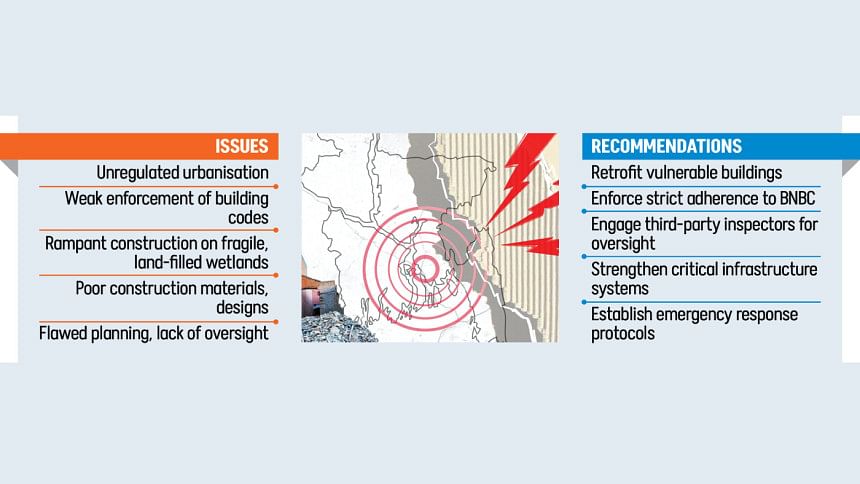
The recent 7.7-magnitude earthquake that struck Myanmar and parts of Thailand serves as yet another warning for Dhaka.
While Myanmar reels from the devastation, with over 3,000 lives lost and thousands injured, experts say Bangladesh remains frighteningly unprepared for a similar disaster.
Given its location in one of the world's most tectonically active regions, Dhaka's vulnerability to a catastrophic earthquake is not a matter of if, but when.
According to the earthquake disaster risk index, the capital tops the list of the 20 most vulnerable cities in the world.
A study by Rajuk estimates that a 6.9-magnitude earthquake along the Madhupur Fault Line could flatten over 850,000 buildings in the capital, causing over two lakh deaths and leaving another two lakh injured.
The survey was conducted for four years, from 2018 to 2022.
Financial losses could surpass $25 billion, with an additional $44 billion required for reconstruction.
The Comprehensive Disaster Management Plan (CDMP) identifies five major fault zones in Bangladesh -- Madhupur Fault, Dauki Fault, Plate Boundary Fault-1, Plate Boundary Fault-2, and Plate Boundary Fault-3 -- each capable of generating earthquakes between magnitudes 7 and 8.5.
Despite these alarming projections, earthquake preparedness in Dhaka remains almost nonexistent, said Dr Mehedi Ahmed Ansary of the Department of Civil Engineering at Buet.
Experts point to unregulated urbanisation, weak enforcement of building codes, and rampant construction on land-filled wetlands as major contributors to the city's seismic risk.
IGNORING CONSTRUCTION STANDARDS
Dr Ansary said that in the event of a major earthquake, Dhaka would be a city of collapsed buildings, most constructed without adhering to the Bangladesh National Building Code (BNBC).
Poor construction materials, flawed structural designs, and unregulated expansion are turning thousands of buildings in the city into death traps.
"If an earthquake of magnitude 7 or higher strikes Dhaka, many buildings will collapse instantly," he said. "Earthquakes do not kill people -- poorly built structures do."
The 2023 Turkey earthquake (magnitude 7.8) killed around 53,500 people, primarily due to building collapses.
In contrast, the 2010 Haiti earthquake (magnitude 7.0) caused nearly 230,000 deaths due to weak buildings, whereas the 2010 Chile earthquake (magnitude 8.8) killed only 280 people.
Despite releasing 800 times more energy than the Haiti earthquake, Chile's strong construction practices saved lives, he said.
Dhaka is following the same disastrous path as Haiti and Turkey. Unauthorised residential projects, particularly in Dhaka's eastern and western areas, have been built by filling floodplains, wetlands, and water bodies without proper piling to stabilise the soil. High-rise buildings continue to sprout on weak foundations, putting millions at risk, he added.
FLAWED PLANNING AND A LACK OF OVERSIGHT
Adil Mohammed Khan, president of the Bangladesh Institute of Planners, describes Bangladesh's cities as completely unprepared for a major earthquake.
"The recent Myanmar earthquake highlights our lack of preparedness. Construction continues without following building codes, master plans, or land-use zoning regulations," he said.
Although the Detailed Area Plan (DAP) suggests area-based variations in building size and height, recent amendments propose a uniform Floor Area Ratio (FAR) across Dhaka, disregarding geological risks.
"No city in the world follows such a reckless planning model. Yet, Dhaka, one of the most unlivable and high-risk cities, continues to do so," he warned.
A major concern is the lack of clear mapping for Dhaka's utility networks.
A senior Rajuk official pointed out that gas leaks could cause massive fires, water supply lines could rupture, and blocked roads from collapsed buildings would make rescue efforts nearly impossible.
The city's shortage of open spaces would further cripple emergency responses.
URGENT MEASURES NEEDED
Given the vulnerability of Dhaka's buildings, Prof Ansary suggested classifying structures into three categories -- weak (red), moderately weak (yellow), and relatively strong (green).
This would allow authorities to prioritise retrofitting efforts.
He said a similar initiative has successfully strengthened nearly 500 garment industry buildings under the Ministry of Labour.
Furthermore, third-party engineering firms should oversee construction quality to ensure adherence to BNBC guidelines.
City authorities such as Rajuk, CDA, KDA, and RDA must issue occupancy certificates only after independent verification, he said.
Dhaka's critical infrastructure -- electricity, gas, telecommunications, transport, and water supply -- must be reinforced against earthquakes, he added.
Experts also recommended a risk-sensitive map to guide construction and emergency shutdown protocols to prevent secondary disasters, such as gas explosions.
Md Nurul Islam, chief engineer (implementation) at Rajuk, said they have recently formed teams to monitor all the newly constructed buildings especially high-rise buildings.
They will follow whether the buildings are being constructed following the BNBC standards and building construction rules, he added.

 For all latest news, follow The Daily Star's Google News channel.
For all latest news, follow The Daily Star's Google News channel. 



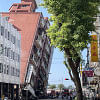

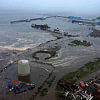

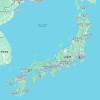

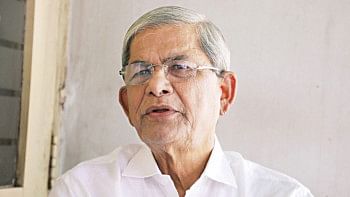
Comments